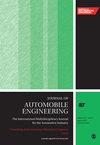插电式混合动力电动汽车低温环境下的发动机余热回收
IF 1.5
4区 工程技术
Q3 ENGINEERING, MECHANICAL
Proceedings of the Institution of Mechanical Engineers Part D-Journal of Automobile Engineering
Pub Date : 2024-04-13
DOI:10.1177/09544070241238297
引用次数: 0
摘要
在低温环境下,电动汽车动力电池的性能和寿命都会降低,电动汽车内较低的温度也会影响驾驶员和乘客的舒适度。考虑到冬季的气温和插电式混合动力电动汽车独特的驱动结构,专门设计了低温环境下的驱动模式。在此驱动模式的基础上,提出了一种插电式混合动力电动汽车(PHEV)集成热管理结构,用于加热电池和乘客舱,从而提高能源效率。我们利用数学模型建立了整个车辆热管理系统,并对其进行了实验验证。在环境温度分别为 -5°C、-10°C、-15°C 和 -20°C 的 NEDC(新欧洲驾驶循环)条件下,对发动机余热利用和 PTC(正温度系数)加热的计算结果进行了比较和分析。结果表明,在低温条件下,本研究提出的热管理系统的平均加热速度比 PTC 加热快 23%。采用发动机余热利用时,SOC 降至 63.43%。采用 PTC 加热时,SOC 降至 49.18%。不过,随着环境温度的降低,发动机余热利用率快于 PTC 加热的优势就不那么明显了。本文章由计算机程序翻译,如有差异,请以英文原文为准。
Recovery of engine waste heat in low temperature environment of plug-in hybrid electric vehicle
The performance and life of electric vehicle power batteries will be reduced at low temperatures, and the lower temperature in the electric vehicle will also affect the comfort of drivers and passengers. Taking into account the winter temperatures and the unique drive structure of the plug-in hybrid electric vehicle, a specially designed driving mode for low-temperature environment is implemented. Based on this drive mode, a plug-in hybrid electric vehicle (PHEV) integrated thermal management structure is proposed to heat the battery and the passenger compartment, thereby improving energy efficiency. A mathematical model is used to establish the entire vehicle thermal management system, which is then experimentally validated. Under the NEDC (New European Driving Cycle) at ambient temperatures of −5°C, −10°C, −15°C, and −20°C, the calculation results of engine waste heat utilization and PTC (Positive Temperature Coefficient) heating are compared and analyzed. The results show that the average heating rate of the thermal management system proposed in this study is 23% faster than that of PTC heating at low temperature. The SOC decreases to 63.43% when engine waste heat utilization is adopted. When PTC heating is used, the SOC decreases to 49.18%. However, the advantage of the faster rate of engine waste heat compared to PTC heating becomes less pronounced as the ambient temperature decreases.
求助全文
通过发布文献求助,成功后即可免费获取论文全文。
去求助
来源期刊

CiteScore
4.40
自引率
17.60%
发文量
263
审稿时长
3.5 months
期刊介绍:
The Journal of Automobile Engineering is an established, high quality multi-disciplinary journal which publishes the very best peer-reviewed science and engineering in the field.
 求助内容:
求助内容: 应助结果提醒方式:
应助结果提醒方式:


